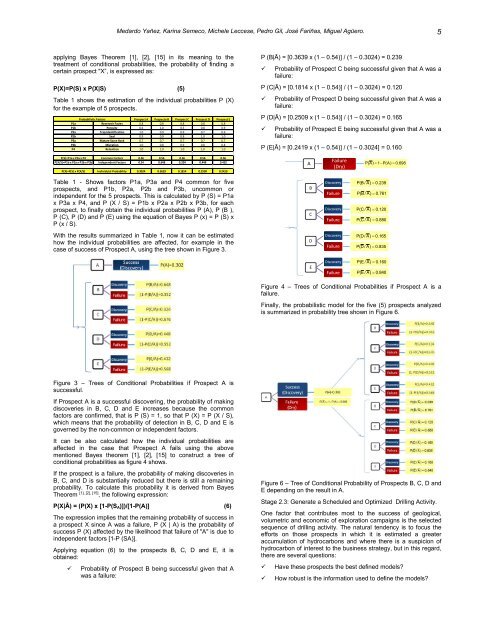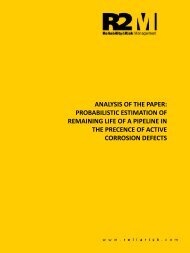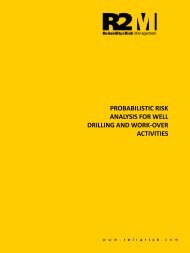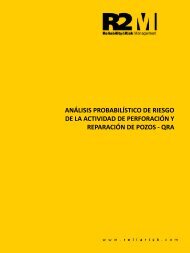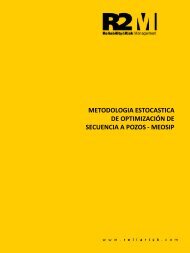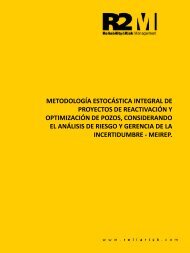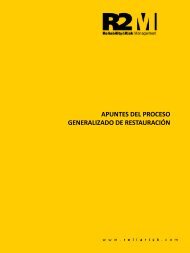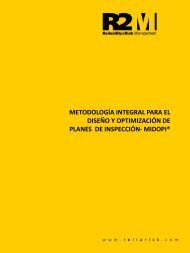Stochastic Evaluation of Exploration Assets - MEIVAE
You also want an ePaper? Increase the reach of your titles
YUMPU automatically turns print PDFs into web optimized ePapers that Google loves.
Medardo Yañez, Karina Semeco, Michele Leccese, Pedro Gil, José Fariñas, Miguel Agüero. 5<br />
applying Bayes Theorem [1], [2], [15] in its meaning to the<br />
treatment <strong>of</strong> conditional probabilities, the probability <strong>of</strong> finding a<br />
certain prospect "X”, is expressed as:<br />
P(X)=P(S) x P(X|S) (5)<br />
Table 1 shows the estimation <strong>of</strong> the individual probabilities P (X)<br />
for the example <strong>of</strong> 5 prospects.<br />
Probabilistic Factors<br />
Prospect A Pospecto B Prospect C Prospect D Prospect E<br />
P1a Reservoir Facies 0.8 0.8 0.8 0.8 0.8<br />
P1b Porosity 0.6 1.0 0.5 0.8 0.9<br />
P2a Trap Identification 1.0 0.9 0.9 0.7 0.6<br />
P2b Seal 0.9 0.9 0.8 1.0 1.0<br />
P3a Mature Sorce Rock 0.7 0.7 0.7 0.7 0.7<br />
P3b Migration 1.0 0.8 0.9 0.8 0.8<br />
P4 Retention 1.0 1.0 1.0 1.0 1.0<br />
P (B|Ā) = [0.3639 x (1 – 0.54)] / (1 – 0.3024) = 0.239<br />
<br />
Probability <strong>of</strong> Prospect C being successful given that A was a<br />
failure:<br />
P (C|Ā) = [0.1814 x (1 – 0.54)] / (1 – 0.3024) = 0.120<br />
<br />
Probability <strong>of</strong> Prospect D being successful given that A was a<br />
failure:<br />
P (D|Ā) = [0.2509 x (1 – 0.54)] / (1 – 0.3024) = 0.165<br />
<br />
Probability <strong>of</strong> Prospect E being successful given that A was a<br />
failure:<br />
P (E|Ā) = [0.2419 x (1 – 0.54)] / (1 – 0.3024] = 0.160<br />
P(S)=P1a x P3a x P4 Common Factors 0.56 0.56 0.56 0.56 0.56<br />
P(X/S)=P1b x P2a x P2b x P3b Independent Factors 0.54 0.648 0.324 0.448 0.432<br />
P(X)=P(S) x P(X/S) Individuial Probability 0.3024 0.3629 0.1814 0.2509 0.2419<br />
A<br />
Failure<br />
(Dry)<br />
P(A)<br />
1-P(A)=0.698<br />
1<br />
0.698<br />
Table 1 - Shows factors P1a, P3a and P4 common for five<br />
prospects, and P1b, P2a, P2b and P3b, uncommon or<br />
independent for the 5 prospects. This is calculated by P (S) = P1a<br />
x P3a x P4, and P (X / S) = P1b x P2a x P2b x P3b, for each<br />
prospect, to finally obtain the individual probabilities P (A), P (B ),<br />
P (C), P (D) and P (E) using the equation <strong>of</strong> Bayes P (x) = P (S) x<br />
P (x / S).<br />
B<br />
C<br />
Discovery<br />
Failure<br />
Discovery<br />
Failure<br />
P(B P(B/A)=0.648<br />
/<br />
0.239<br />
(1-P(B/A))=0.352<br />
/<br />
0.761<br />
P(C P(C/A)=0.324<br />
/<br />
0.120<br />
(1-P(C/A))=0.676<br />
/<br />
0.880<br />
With the results summarized in Table 1, now it can be estimated<br />
how the individual probabilities are affected, for example in the<br />
case <strong>of</strong> success <strong>of</strong> Prospect A, using the tree shown in Figure 3.<br />
D<br />
Discovery<br />
Failure<br />
P(D P(D/A)=0.448<br />
/<br />
0.165<br />
(1-P(D/A))=0.552<br />
/<br />
0.835<br />
E<br />
Discovery<br />
Failure<br />
P(E P(E/A)=0.432<br />
/<br />
0.160<br />
(1-P(E/A))=0.568<br />
/<br />
0.840<br />
Figure 4 – Trees <strong>of</strong> Conditional Probabilities if Prospect A is a<br />
failure.<br />
Finally, the probabilistic model for the five (5) prospects analyzed<br />
is summarized in probability tree shown in Figure 6.<br />
Figure 3 – Trees <strong>of</strong> Conditional Probabilities if Prospect A is<br />
successful.<br />
If Prospect A is a successful discovering, the probability <strong>of</strong> making<br />
discoveries in B, C, D and E increases because the common<br />
factors are confirmed, that is P (S) = 1, so that P (X) = P (X / S),<br />
which means that the probability <strong>of</strong> detection in B, C, D and E is<br />
governed by the non-common or independent factors.<br />
It can be also calculated how the individual probabilities are<br />
affected in the case that Prospect A fails using the above<br />
mentioned Bayes theorem [1], [2], [15] to construct a tree <strong>of</strong><br />
conditional probabilities as figure 4 shows.<br />
If the prospect is a failure, the probability <strong>of</strong> making discoveries in<br />
B, C, and D is substantially reduced but there is still a remaining<br />
probability. To calculate this probability it is derived from Bayes<br />
Theorem [1], [2], [15] , the following expression:<br />
P(X|Ā) = (P(X) x [1-P(S A)])/[1-P(A)] (6)<br />
The expression implies that the remaining probability <strong>of</strong> success in<br />
a prospect X since A was a failure, P (X | A) is the probability <strong>of</strong><br />
success P (X) affected by the likelihood that failure <strong>of</strong> "A" is due to<br />
independent factors [1-P (SA)].<br />
Applying equation (6) to the prospects B, C, D and E, it is<br />
obtained:<br />
<br />
Probability <strong>of</strong> Prospect B being successful given that A<br />
was a failure:<br />
Figure 6 – Tree <strong>of</strong> Conditional Probability <strong>of</strong> Prospects B, C, D and<br />
E depending on the result in A.<br />
Stage 2.3: Generate a Scheduled and Optimized Drilling Activity.<br />
One factor that contributes most to the success <strong>of</strong> geological,<br />
volumetric and economic <strong>of</strong> exploration campaigns is the selected<br />
sequence <strong>of</strong> drilling activity. The natural tendency is to focus the<br />
efforts on those prospects in which it is estimated a greater<br />
accumulation <strong>of</strong> hydrocarbons and where there is a suspicion <strong>of</strong><br />
hydrocarbon <strong>of</strong> interest to the business strategy, but in this regard,<br />
there are several questions:<br />
<br />
<br />
Have these prospects the best defined models?<br />
How robust is the information used to define the models?


